The Citizens’ Brigade to Save LACMA, an activist group riled by Swiss architect Peter Zumthor’s revamp of the Los Angeles County of Museum of Art (LACMA) and the “catastrophic impact” it poses on the 110-year-old institution and L.A. culture at large, has unveiled the six finalists in its LACMA not LACKma international design competition.
A juried protest competition of sorts, launched last month in search of alternative proposals to Zumthor’s highly contentious $750 million plan, the proposals solicited by the Citizens’ Brigade—28 in total were submitted—were required to imagine corrective “solutions that would expand gallery space rather than shrink it, and use less rather than more land, while providing a home for the collections and services needed for their care.”
To be clear, the Citizens’ Brigade, a collection of design professionals, art experts, and the general public, isn’t staunchly opposed to demolishing some buildings on LACMA’s 1960s-era Wilshire Boulevard campus to make way for a new one. It is, however, concerned about the overall diminishing, growth-prohibiting effect that the redesign will have on the museum’s collections. “The design fails the collections, which will be stored or dispersed to other locations,” explained the group, noting that Zumthor’s vision also “consumes too much land and costs an extravagant price per square foot” while doing away with curator services and the on-site library.
Proposals submitted to the competition fall under two categories; the adaptive reuse-focused Existing Buildings and Ground Up, which entails entirely new and more appropriate designs. Three finalists were chosen from each category. As the competition website states: “We are not proposing that any one of them be built as is, but simply suggesting that the public, the museum board, and the County Board of Supervisors view them as possible starting points for developing alternatives that truly capture people’s eyes, hearts, and minds, and showcase LACMA’s collections in a practical and architecturally stimulating environment.”
The six finalists, which will each receive $1,500 in prize money provided by an anonymous backer, were selected by a jury that included Aaron Betsky, architecture critic and newly instated director of the Virginia Tech School of Architecture and Design; author, critic, and co-chair of the Citizens’ Brigade, Greg Goldin; Joseph Giovannini, an architect who also serves as architecture critic for the Los Angeles Review of Books and co-chair of the Citizens’ Brigade; William Pedersen of New York-based firm Kohn Pedersen Fox; educator and architect Winka Dubbeldam; Los Angeles-based architect and activist Barton Phelps, and former LACMA curator J. Patrice Marandel.
“We at The Citizens’ Brigade to Save LACMA are impressed with the creativity, sensitivity, and passion these international architects brought to their ideas, as well as the generosity of their considerable time and effort,” said Giovannini in a statement.
It’s now in the hands of the public to select an overall winner from each category via online voting. Each winner will receive an additional $500 prize. Voting is open until May 15. An additional nine submitted proposals considered as “Ideas of Merit” will also be shared on the competition website in the coming days.
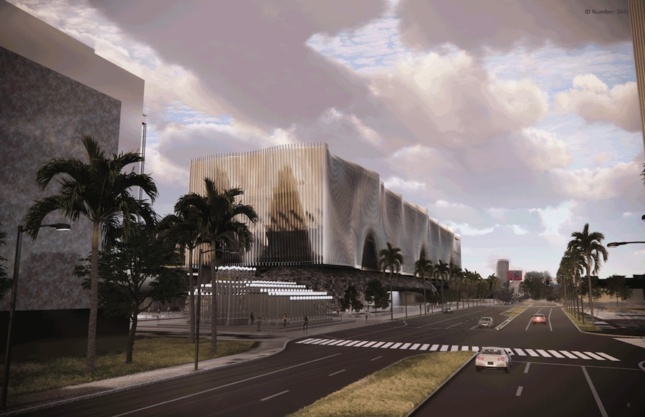
HILLACMA: TheeAe (The Evolved Architectural Eclectic), Hong Kong (Ground Up)
“TheeAe (The Evolved Architectural Eclectic) considers Los Angeles’ diversity when proposing the museum as ‘a new cultural platform that connects people from different walks of life,’ by simultaeneously offering enclosed cultural spaces and an open, sculpted, outdoor landscape. The tall building (five levels plus garden roof) combines an undulating facade along Wilshire Boulevard to the south with ‘hill’ element sloping into the park on the property’s north side. The jury remarked that the dramatic hybrid design would make it a ‘destination building’ cleverly designed to sustain the urbanity of Wilshire on one side while extending the bucolic nature of the park on the other. ‘The Wilshire facade becomes a kinetic wall, imparting a strong urban experience that changes as you drive by, which is how most Angelenos experience the city,’ noted the jury. ‘The back facade, a built hillside, is a landscape event that adds a surprising new participatory dimension to Hancock Park. This will be a hill you want to climb.’”
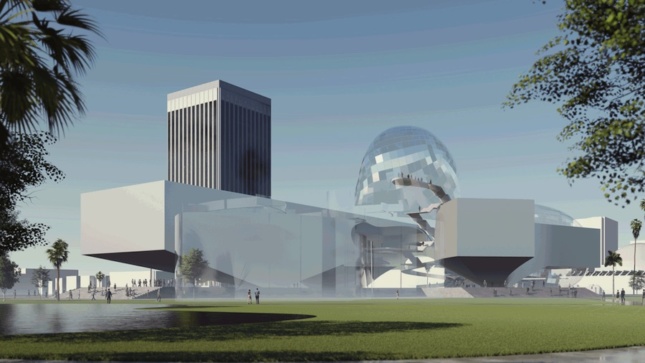
LACMA Wing: Coop Himmelb(I)au, Vienna (Ground Up)
“Emphasizing ‘an architecture that combines functionality with aspiration,’ Coop Himmelb(l)au designed three main elements: landscape plinth and two, three-level ‘floating’ gallery wings. Public circulation on ramps connecting the volumes would be encased by expressive amorphous forms whose openness to the outside refreshes the museum visiting experience. These public spaces are accessible without a ticket to the museum, but windows into the galleries are meant to entice people inside. The jury appreciated the curatorial flexibility of generous gallery spaces, with 22-foot floor-to-ceiling heights, the possibility of mezzanines and intimate galleries, and open floor plates. ‘This entry combines issues of great efficiency with moments of drama,’ noted the jury. ‘The ‘bubbles’ offer exciting spaces that celebrate the public realm while connecting to straightforward, practical, functional galleries in the wings.’”
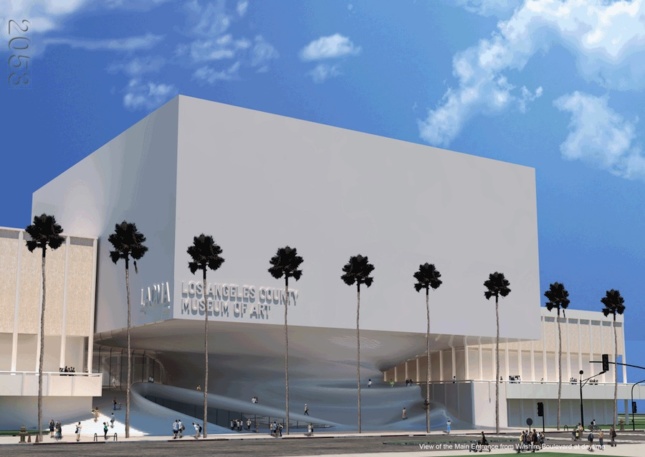
Reimagining/Restructuring: Saffet Kaya Design, London (Existing Buildings)
“Replacing the 1986 building, Kaya Design proposes ‘to preserve the best elements of the past while creating a more contemporary, multi-use alternative space.’ An elevated volume that respects the scale of the existing structures has solid walls on three sides for curatorial flexibility, then opens to the north with an all-glass façade. Circulation into the entrance is through a gentle ramp/walkway leading into the lobby that directs visitors to the other buildings on other floors—the ramps equalizing the importance of all adjacent floors. The new structure is reserved for exhibition space on six above-grade levels, including the interior of the spiral element. ‘This design achieves a considerable service to the campus, making the east campus more coherent than it’s ever been,” said the jury. ‘The biological form of the spiral—as ancient as seashells and hurricanes—gives value to the floors it connects.’”
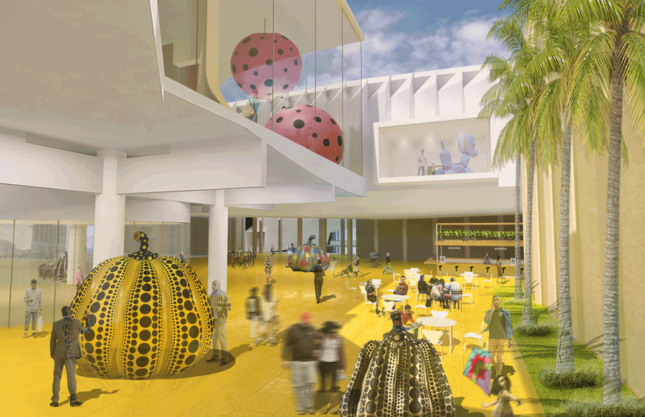
Re(in)novating LACMA: RUR Architecture, Reiser + Umemoto, New York City (Existing Buildings)
“Reiser + Umemoto’s aim was ‘to create a coherent, retroactive masterplan that builds off the campus’ prior successes and seeks to engage and reinvigorate the full breadth of LACMA’s collection.’ The three-pronged approach includes adding new elements in and around the original 1965 buildings, binding them into a new whole. The Cone sits within and atop the Ahmanson; The Bar, an elevated gallery building, transects the campus from north to south, offering an appropriately scaled Wilshire entrance and new gallery space; The Cluster replaces the 1986 building with a series of interior pod-shaped galleries, as well as exterior exhibition space on a reimagined plaza level. ‘The architects found a way to make the plaza into a connective tissue and strategically make the existing buildings work as an ensemble,’ said the jury, which also commended the clear circulation that employed new interstitial spaces to move people through the building’s interior spaces.”
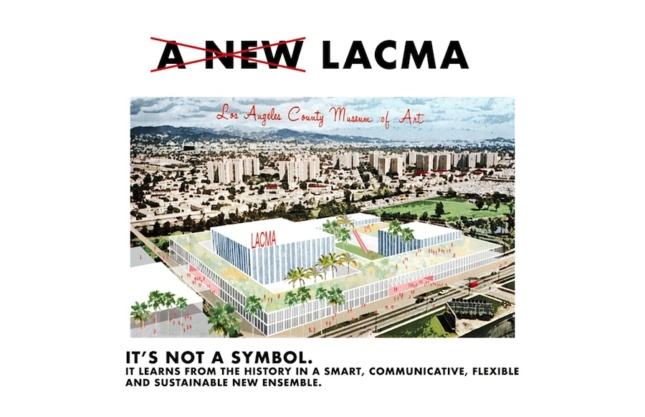
Tabula LACMA: Barkow Leibinger, Berlin, with Lillian Montalvo Landscape Design (Existing Buildings)
“This ‘reconstitution’ is an unusual hybrid of old and new, as it maintains the scale and context of the original LACMA buildings by reconstructing them with modern, sustainable materials, then interconnecting them with a new plinth form punctured by courtyards. Barkow Leibinger—working with landscape designer Lillian Montalvo—stresses this would ‘provide spaces for art, delight, and public encounter.’ The jury thought this flexible, spacious design addressed the changing role of museums by including a good amount of shopping, cafés, and event venues that urbanize the spaces and engender a lively environment. ‘There’s a powerful idea of using the area around the pavilions to create a whole new programmed space,’ according to the jurors. They enjoyed the rediscovery of the inner plaza and could ‘imagine these would be great spaces to be in, as well as fun to discover.’”
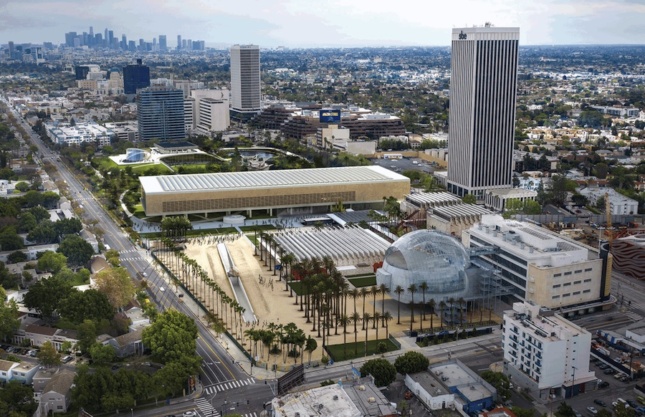
Unified Campus: Paul Murdoch Architects, Los Angeles (Ground Up)
“To create greater institutional cohesion, Paul Murdoch Architects took a holistic approach to the entire LACMA campus and its relationship to the cultural institutions flanking it. The design, according to the architects, is ‘expressive of LA in its openness, multiplicity of urban, natural, and cultural connections, and abundant use of controlled natural light.’ The jury noted how this horizontal skyscraper—an on-axis version of the neighboring tower across Wilshire—corresponds to the urbanism of the area. ‘It restores the continuity of the Wilshire Boulevard streetfront with a respectful attitude by placing the narrow part of the building facing the street and the broad side framing the park.’ The east glass façade offers a strong, complementary visual connection to Hancock Park and the La Brea Tar Pits, and the west ̧facade forms a long public plaza bordered by BCAM and the Resnick Pavilion, uniting the two campuses.”











